Single Parents, Unmarried Parents and Cohabiting Couples Statistics
Updated September 2024
CSO Vital Statistics – 2023
The 2023 Vital Statistics from the Central Statistics Office (CSO) show several key updates:
Over the last decade, the number of births registered fell from 68,930 in 2013 to 54,678 in 2023.
40.8% or 24,754, were born outside of marriage/civil partnerships, and of these, 26% were to co-habiting parents.
- The highest percentage of births outside marriage was again in Limerick City, at 55.4%. Meanwhile, Dun Laoghaire-Rathdown continues to have the lowest rate, with 27.9% of births outside marriage or civil partnership.
- The average age of mothers outside marriage or civil partnerships rose slightly to 33.2 years.
Census 2022
On the night of the 2022 Census there were 1,279,951 families recorded, that is a 5% increase on 2016.
- 2022 Census showed 85,262 co-habiting couples with children – this is a 12.7% increase on the 2016 Census.
- Census 2022 showed a slight decrease in the number of mother’s parenting alone, but a slight increase in the number of fathers parenting alone.
Same Sex Couples
In 2022, there were 10,393 same-sex couples in Ireland – an increase of 72% since 2016.
The total number of children in same-sex couple family units was 1,853, an increase of 86% compared with 2016.
Just under a third were only children within their family unit.
Statistics Infographic
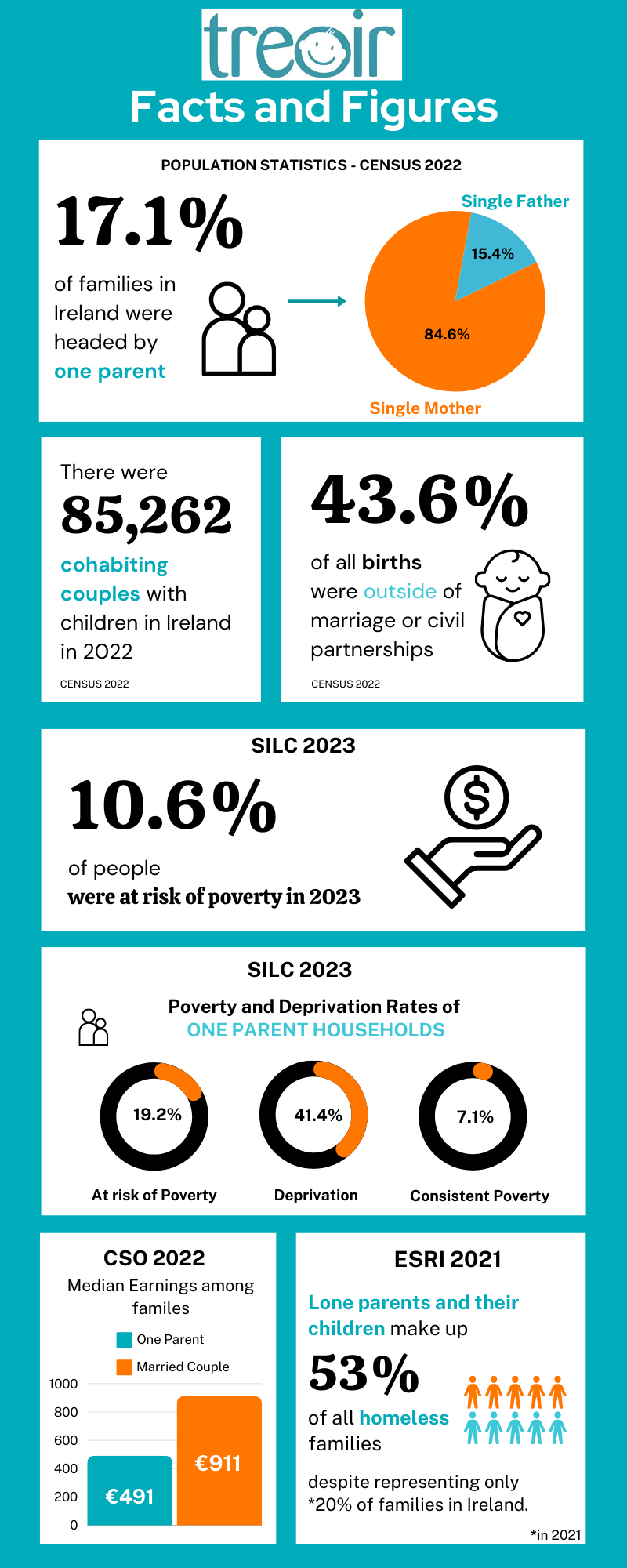
State of the Nations Children Report – 2023
Single Parent Family Unit Statistics
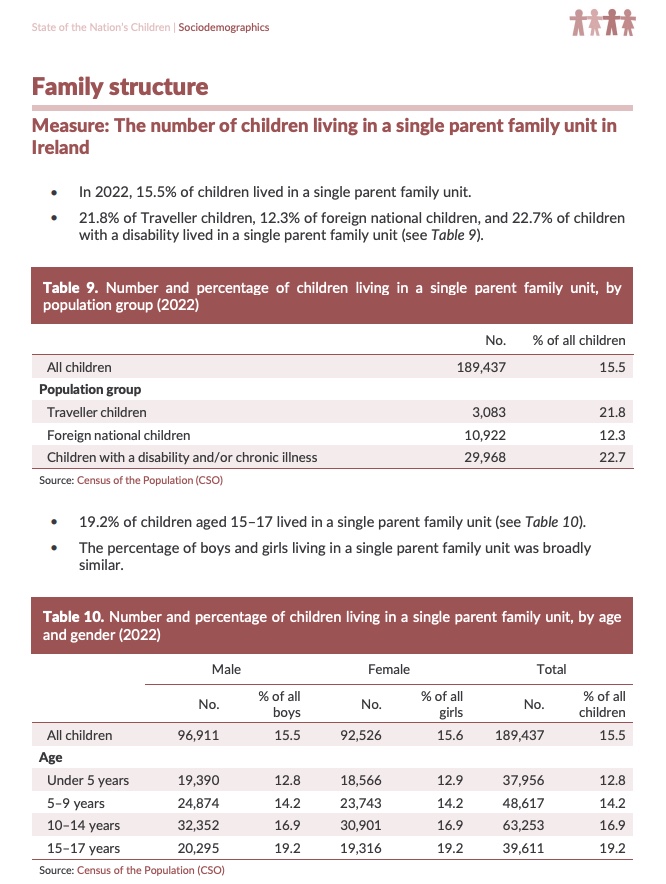
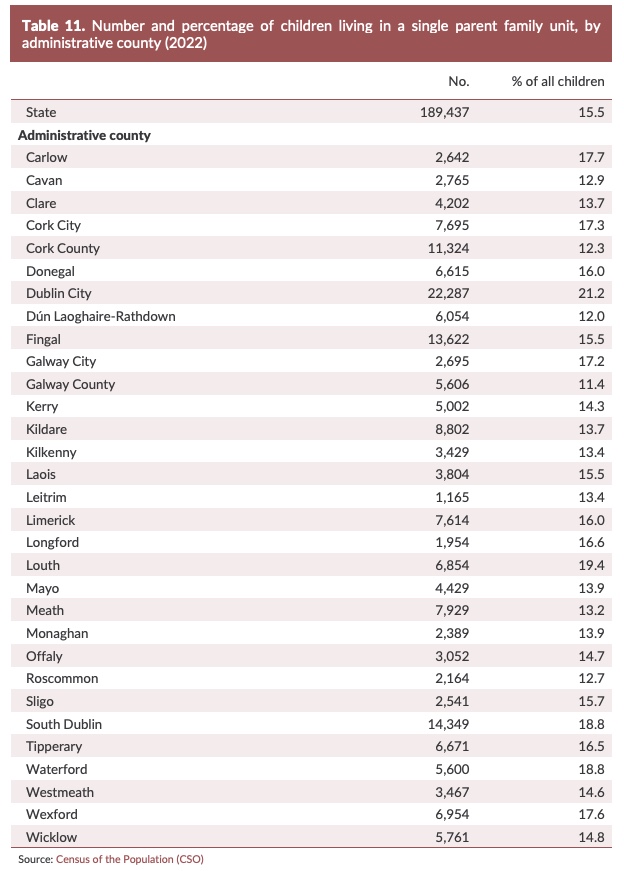
Past Statistics
SILC 2022
In 2022 13.1% of the population were at risk of poverty compared to 11.6% in 2021.
Without the COVID-19 income supports in 2022, 20.5% of people would have been at risk of poverty.
Lone parent households continue to be one of the population cohorts that are most at risk of poverty at 23.8%, compared to 13.1% in the overall population.
14.1% of lone parent families live in consistent poverty compared to 5.3% of the overall population.
SILC – 2018
COMPARATIVE STATISTICAL ANALYSIS OF ONE PARENT FAMILIES (OPFs) POVERTY AND DEPRIVATION RATES AND NATIONAL AVERAGES – SILC DATA 2018
The following highlights consistent high levels of poverty and deprivation amongst one-parent families by comparing current poverty rates with national averages following release of CSO 2018 SILC data.
Survey on Income and Living Conditions (SILC) 2017
OPFs vs National Averages
At risk of poverty
In 2018, the at risk of poverty rate was for general population was 14%, a reduction of 1.7% on 2017 figures. However, the at risk of poverty rates continue to remain high amongst one-parent families (OPFs) at a rate of 33.5%, meaning OPF households continue to be approximately 2.5 times more likely to experience poverty than other cohorts (CSO Ireland, 2019).
Deprivation
In 2018, the national deprivation rate was 15.1%, a significant reduction of 3.7% on 2017 figures. In contrast, there was an insignificant reduction in deprivation rates for OPFs in 2018 of 1.8%. In comparison with the national average, deprivation rates remain high for OPFs at 42.7% in 2018 (CSO Ireland, 2019).
Consistent poverty
In 2018, the consistent poverty rate was 5.6% which is a significant reduction of 1.1% on 2017. In comparison, the consistent poverty rates for OPFs was 19.2% meaning OPFs remain three times for likely to experience consistent poverty based on national averages (CSO Ireland, 2019).
SILC 2017
SILC 2017 – One Parent Families (OPFs) vs National Averages
At risk of poverty
Deprivation
Consistent poverty
| OPF vs National Averages – At risk of poverty | |||
| Year | 2016 | 2017 | % change |
| National Average | 16.2 | 15.7 | -0.5 |
| OPFs | 40.2 | 39.9 | -0.3 |
| OPF vs National Averages – Deprivation | |||
| Year | 2016 | 2017 | % change |
| National Average | 21.0 | 18.3 | -2.2 |
| OPFs | 51.1 | 44.5 | -5.6 |
| OPF vs National Averages – Consistent poverty | |||
| Year | 2016 | 2017 | % change |
| National Average | 8.3 | 6.7 | -1.6 |
| OPFs | 24.6 | 20.7 | -3.9 |
Census 2011
Unmarried Parents
Census data indicates that there were approximately 629,116 family units in Ireland with children under 20 in 2010. Of these:
– 140,658 were lone parent families representing 22.4% of all families with children under 20
– 127,651 were to lone mother families, 20.3% of all families
– 13,007 were lone father families, representing 2.1% of all families
There were 979,590 children under 15 living in the State on Census night of whom 138,533 were living in one parent families (14%).
Cohabiting Families
There were 57,671 cohabiting couples with children under 20, representing 9.2% (7.5% in Census 2006) of all couples with children under 20 in 2010.
The number of children of all ages living with cohabiting parents increased from 74,500 in 2006 to 104,665 in 2010, representing an increase of 7%.
CSO Vital Statistics
Vital Statistics from the Central Statistics Office (CSO) for the ‘Vital Statistics Yearly Summary 2015’ show that:
- 36.4% of all births were outside marriage/civil partnership in 2015 (23,990), an increase of 0.1% on 2014
- The highest percentage of births outside of either marriage or civil partnerships was in Limerick City at 55.7%. The lowest was in DunLaoghaire Rathdown at 24.0%
- The average age of mothers outside of marriage/civil partnership was 29.6 years.
- 21.6% of all births were to unmarried parents living at the same address, 59.4% of all births registered as outside marriage were registered by parents at the same address
CSO Vital Statistics 2002 -2014
% of births registered as outside of marriage and % of births registered to parents at the same address*
(cohabiting parents) 2002 – 2014
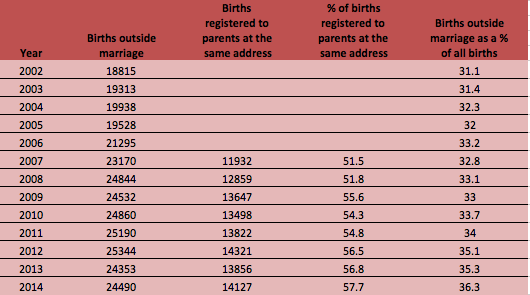
Source: CSO Stats
*This figure is only available since 2007
Births to women outside of marriage by age of mother
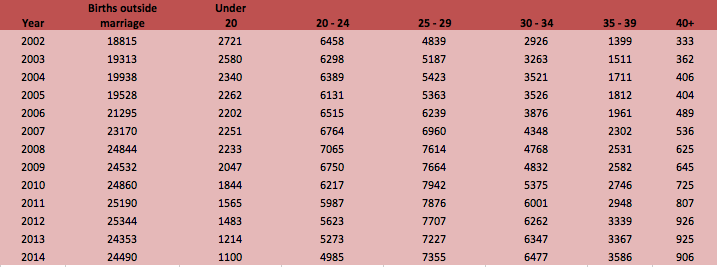
Births to women (outside marriage) under 20 by age of Mother
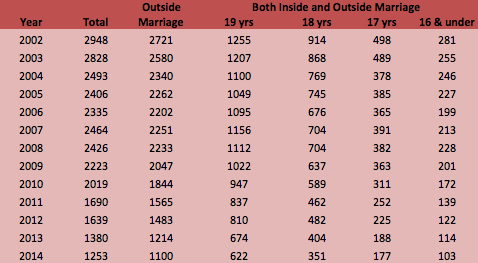
The Adoption Authority of Ireland
Adoption orders and Family Adoptions*
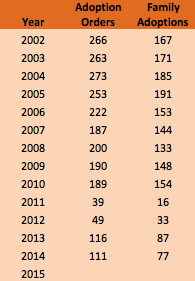
*Adoption by family members, usually mother and her husband
Women From the Republic of Ireland Accessing Abortion Services in England and Wales 2002 – 2015*
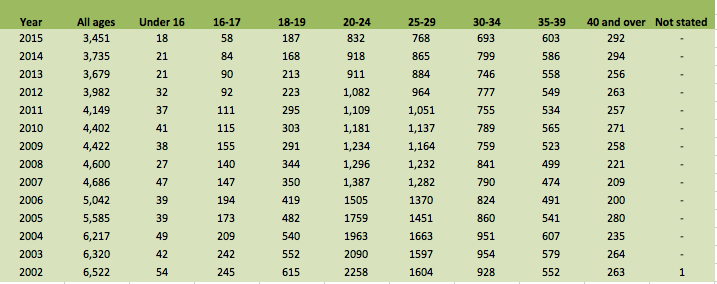
Women From the Republic of Ireland Accessing Abortion Services in the Netherlands 2006 – 2014
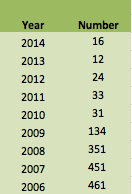
Source: HSE Sexual Health and Crisis Pregnancy Programme
The Department of Social Protection
One Parent Family Payment
One-Parent Family Payment (OPFP) is a means-tested payment for men and women who are caring for a child without the support of a partner.
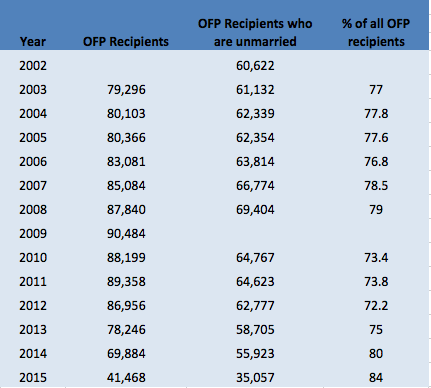
% of children living with two cohabiting (unmarried) parents in 2005 and 2014*
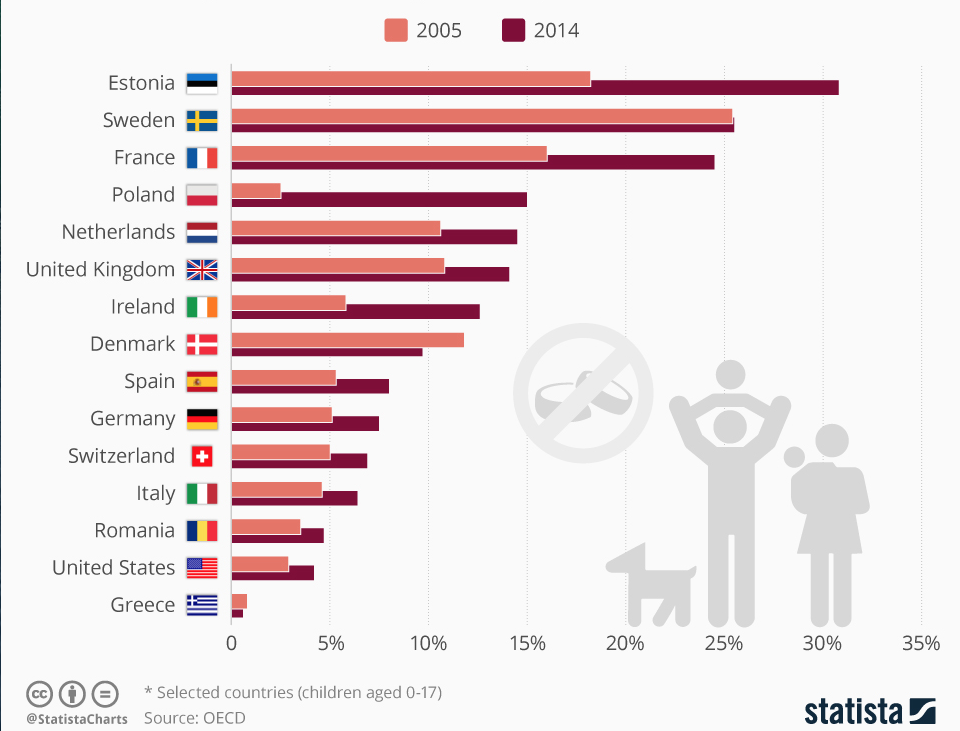
EU Survey on Income and Living Conditions (SILC) data 2013
Published February 2013, 2011 and 2010 Revised Results
The Survey on Income and Living Conditions (SILC) in Ireland is a household survey covering a broad range of issues in relation to income and living conditions. It is the official source of data on household and individual income and also provides a number of key national poverty indicators such as the at risk of poverty rate and the consistent poverty rate.
The EU-SILC figures for 2013 show that one parent families continue to experience a disproportionate level of poverty. It is important to note that one parent families in the context of the EU-SILC data refers to parents who are divorced separated, widowed and parents who have never been married.
Risk of Poverty
- Lone parent households continue to be at a high risk of poverty with a rate of 28.4% being recorded for individuals in these households. This is compared to a 16% at risk of poverty rate in the general population.
- Lone parents represent 7.3% of the population.
- 18.8% of children are at risk of poverty; they experience the highest rate of consistent poverty compared to other population groups (those over 65 years and the 18-64 age cohort).
Deprivation
- Lone parent households report high levels of deprivation at 56%, an increase of 11.9% since 2009. The deprivation rate for the general population is 24.5%.
32.1% of Children were experiencing deprivation in 2011. This figure has increased from 23.5% in 2009.
Consistent Poverty
- 16.4% of lone parent households were living in consistent poverty in 2011, this compares to 6.9% of the general population.
Growing Up in Ireland Survey 2013
The Growing Up in Ireland survey, initiated by Treoir, is an on-going national longitudinal study of children in Ireland. Data has been collected on a large cohort of infants (11,134), who were nine months old when the data was collected in 2008/9, and their parents. Treoir commissioned an analysis of the data relating to unmarried parents. Data was collected on lone unmarried parents and unmarried cohabitant parents. Outcomes for these groups were compared to those for married families who were the ‘reference category’ in the study. Data on crisis pregnancy was also analysed. The full report is available on www.treoir.ie/policy
Crisis Pregnancy
- 16.4% of women experienced an ‘unintended pregnancy’, while just under 16% of women experienced a ‘stressful’ pregnancy, where this stress was solely due to the pregnancy itself.
- Women whose pregnancies were both unintended and stressful at the same time are labeled as experiencing a ‘Pregnancy Crisis’. This group comprised 3.4% of women in the sample.
- Marital status is significantly associated with crisis pregnancy, with unmarried-cohabitant parents 3 times more likely than married parents to experience crisis pregnancy and solo parents 4-5 times more likely.
Solo Parents
- Solo Parents are two and a half times more likely than married parents to live in a household where anyone was receiving some form of social welfare payment.
- Three out of every ten Solo parents (27.7%) were claiming One-parent family payment.
- Solo parents are 10 times more likely to be welfare dependent, 9 times more likely to be on Rent Supplement and half as likely to as married parents to have been on Jobseeker’s Benefit.
- Fared worse on every measure of deprivation
Father’s Involvement
- Fathers in unmarried-cohabiting families were significantly more likely to share parenting duties than were married fathers
- Among solo parents, one quarter had no contact whatsoever with the father of their child.
- Among solo parents, 50% of fathers made no financial contribution to the maintenance of their child.
